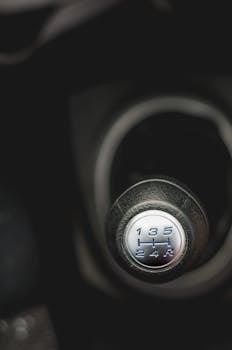
Manual Transmission Troubleshooting⁚ A Comprehensive Guide
This guide offers a comprehensive overview of manual transmission troubleshooting. It helps beginners understand common issues, their causes, and symptoms. Early detection prevents costly repairs. Learn to identify problems like slipping gears, unusual noises, and shifting difficulties. Regular maintenance is vital for a healthy transmission.

Common Symptoms of Manual Transmission Problems
Recognizing early warning signs is crucial for maintaining your manual transmission. Several symptoms indicate potential trouble, preventing extensive damage. Unusual noises are a key indicator; listen for whirring, squealing, bumping, or thumping sounds. Grinding noises during gear changes suggest worn synchronizers or damaged gears. Difficulty shifting gears, feeling shaky, or the transmission jumping out of gear are also red flags.
Slipping gears, where the transmission unexpectedly shifts into neutral, is another common symptom. A car stuck in one gear or unable to engage any gear signals a serious issue. Leaking transmission fluid, often identified by a red or brown fluid under the car, requires immediate attention. A burning smell can indicate overheating or low fluid levels. Vibrations or shaking while driving, especially during gear changes, should not be ignored.
Sloppy gear engagements, where the shifter feels loose or imprecise, suggest worn shift linkage. Ignoring these symptoms leads to more complex and expensive repairs. Addressing these issues promptly ensures the longevity and performance of your manual transmission.
Difficulty Shifting Gears⁚ Causes and Solutions
Difficulty shifting gears in a manual transmission can stem from several underlying issues. One common cause is a worn or damaged clutch. If the clutch isn’t fully disengaging, it makes shifting gears difficult. Solutions include adjusting or replacing the clutch cable or hydraulic system components. Another potential culprit is low or contaminated transmission fluid. Ensure the fluid is at the correct level and replace it if it’s old or dirty.
Worn synchronizers, responsible for matching gear speeds during shifts, can also cause shifting problems. Replacing the synchronizers requires specialized knowledge and tools. Shift linkage issues, such as worn bushings or cables, can lead to sloppy or difficult gear changes. Inspect and replace any worn linkage components to restore smooth shifting.
Internal transmission damage, such as bent shift forks or damaged gears, can also cause shifting problems. These issues often require a complete transmission rebuild or replacement. Finally, ensure the clutch pedal is properly adjusted. An improperly adjusted pedal can prevent the clutch from fully disengaging. Addressing these potential causes helps restore smooth and efficient gear changes.
Grinding Noises During Gear Changes⁚ Identifying the Source
Grinding noises during gear changes in a manual transmission are a telltale sign of trouble, often indicating internal wear or damage. A primary suspect is worn synchronizers. These components match the speeds of the gears before engagement, and when worn, they fail to synchronize properly, resulting in a grinding sound. The severity of the grind can vary depending on the extent of wear.
Another possible source is damaged gear teeth. If the teeth are chipped or broken, they can produce a grinding noise as they attempt to mesh. This damage can occur due to aggressive shifting or excessive wear. Insufficient lubrication can also contribute to grinding noises. Low or contaminated transmission fluid can prevent proper lubrication, leading to increased friction and wear.
Clutch issues, such as a dragging clutch, can also cause grinding. A dragging clutch doesn’t fully disengage, causing the gears to continue spinning even when the clutch pedal is depressed. This makes shifting difficult and can lead to grinding. Finally, worn or damaged bearings within the transmission can also produce grinding noises. Identifying the precise source requires careful inspection and diagnosis.
Slipping Gears⁚ Diagnosing and Addressing the Issue
Slipping gears in a manual transmission is a serious issue that can compromise vehicle control and safety. It occurs when the transmission unexpectedly disengages from the selected gear, often under load. The most common cause is wear on the gear teeth themselves. Over time, the teeth can become rounded or damaged, reducing their ability to stay engaged.
A worn or failing clutch can also cause slipping. If the clutch disc is worn thin, it may not provide enough friction to hold the gears in place, leading to slippage, especially during acceleration or when climbing hills. Issues within the transmission’s internal linkage can also cause this.
Low transmission fluid levels or contaminated fluid can also contribute to gear slippage. Insufficient fluid reduces lubrication, increasing friction and wear. Contaminated fluid can also impede proper gear engagement. Diagnosing the specific cause of slipping gears often requires a thorough inspection of the transmission, clutch, and related components. Addressing the issue promptly is essential to prevent further damage and ensure safe driving. Depending on the cause, repairs may involve replacing the clutch, repairing the transmission, or simply changing the fluid.

Transmission Fluid Leaks⁚ Locating and Repairing Leaks
Transmission fluid leaks are a common problem in manual transmissions and can lead to serious damage if left unaddressed. Identifying the source of the leak is the first crucial step in the repair process. Common leak locations include the input shaft seal, output shaft seal, side cover gaskets, and the drain plug.
To locate a leak, start by inspecting the area around the transmission for signs of fluid. Fresh transmission fluid is typically reddish-brown and has a distinct odor. Clean the transmission case to remove old residue, then run the engine briefly to help pinpoint the leak’s origin. Use a flashlight to examine hard-to-reach areas.
Once the leak is identified, the repair process depends on the location and severity. A loose drain plug can often be tightened, while leaking seals or gaskets require replacement. This usually involves disassembling the transmission to access the affected parts. Always use high-quality replacement parts and follow the manufacturer’s instructions carefully during reassembly. Regularly checking transmission fluid levels and addressing leaks promptly can prevent costly repairs and extend the life of the transmission. Ignoring leaks can lead to low fluid levels, causing overheating and eventual transmission failure.

Unusual Sounds from the Transmission⁚ Interpreting the Noises
Unusual noises emanating from your manual transmission often signal underlying problems that require immediate attention. Identifying the specific type of sound can provide valuable clues about the source of the issue. Grinding noises during gear changes typically indicate worn synchronizers or damaged gears. These sounds often become more pronounced as the transmission wears further.
Whining or humming noises, especially at certain speeds, can point to failing bearings within the transmission. These noises may change in pitch or intensity as the vehicle accelerates or decelerates. Clunking sounds, on the other hand, are often associated with loose or worn components in the shift linkage or differential. These noises are most noticeable when shifting gears or during abrupt changes in acceleration.
Rattling sounds can indicate loose bolts or internal parts that are vibrating excessively. Ignoring these sounds can lead to more serious damage over time. It’s crucial to accurately interpret these noises to diagnose the problem effectively. If you’re unsure about the source of the sound, seeking professional assistance from a qualified mechanic is highly recommended. Early diagnosis and repair can prevent extensive damage and costly repairs in the long run. Regular inspections and maintenance can also help detect and address potential issues before they escalate.
Stuck in One Gear⁚ Troubleshooting Steps
When your manual transmission gets stuck in one gear, it can be a frustrating and potentially dangerous situation. Here’s a step-by-step guide to help you troubleshoot the problem. First, check the shift linkage. The linkage connects the gear shifter to the transmission, and if it’s loose, bent, or broken, it can prevent you from changing gears. Inspect the linkage for any visible damage or excessive play.
Next, examine the clutch. A worn or damaged clutch can prevent the transmission from disengaging properly, making it difficult to shift gears. If the clutch pedal feels spongy or doesn’t return to its normal position, it may indicate a problem with the clutch. Check the clutch cable or hydraulic system for leaks or damage.
If the shift linkage and clutch appear to be in good condition, the problem may lie within the transmission itself. Internal issues such as bent shift forks, damaged gears, or a seized synchronizer can cause the transmission to get stuck in gear. In such cases, it’s best to seek professional help from a qualified mechanic. Attempting to repair the transmission yourself without the necessary tools and expertise can lead to further damage. Remember to always prioritize safety when troubleshooting transmission problems.
Clutch Problems Affecting the Transmission
Clutch problems can significantly impact the performance and functionality of a manual transmission. The clutch is responsible for disengaging the engine from the transmission, allowing for smooth gear changes. When the clutch malfunctions, it can lead to various transmission-related issues.
One common problem is a slipping clutch. This occurs when the clutch disc fails to properly grip the flywheel, resulting in a loss of power and acceleration. Symptoms of a slipping clutch include a high engine RPM without a corresponding increase in speed, difficulty climbing hills, and a burning smell. A worn clutch disc, contaminated friction surfaces, or a weak pressure plate can cause clutch slippage.
Another issue is a dragging clutch, where the clutch fails to fully disengage, making it difficult to shift gears, especially into first or reverse. This can be caused by a bent or damaged clutch disc, air in the hydraulic system, or a misadjusted clutch cable. A sticking clutch pedal can also indicate a problem with the clutch mechanism. Addressing clutch problems promptly is crucial to prevent further damage to the transmission and ensure smooth and efficient gear changes.
Shift Linkage Wear⁚ Recognizing and Correcting Sloppiness
Shift linkage wear is a common issue in manual transmissions, leading to sloppy and imprecise gear changes. The shift linkage connects the gear lever to the transmission, allowing the driver to select the desired gear. Over time, the components of the shift linkage, such as bushings, cables, and joints, can wear out, resulting in excessive play and reduced responsiveness.
Recognizing shift linkage wear involves noticing symptoms like difficulty engaging gears, a vague or loose feeling in the gear lever, and excessive movement of the lever without corresponding gear changes. The gearshift might feel imprecise, requiring extra effort to find the correct gear. In severe cases, the transmission might even pop out of gear.
Correcting shift linkage sloppiness typically involves replacing worn components. Bushings are a common culprit and are relatively inexpensive to replace. Cables can stretch or fray over time, requiring replacement to restore proper tension. Joints and connections can also develop play, necessitating repair or replacement. Addressing shift linkage wear improves shifting precision, restores driver confidence, and prevents potential damage to the transmission. Regular inspection and maintenance can help identify and correct shift linkage issues early on.

Importance of Regular Maintenance for Manual Transmissions
Regular maintenance is crucial for ensuring the longevity and optimal performance of manual transmissions. Unlike automatic transmissions, manuals often require less frequent servicing, but neglecting maintenance can lead to significant problems. A key aspect of maintenance is regularly checking and changing the transmission fluid. Fresh fluid lubricates internal components, dissipates heat, and removes contaminants, preventing wear and tear.
Inspecting the shift linkage is also important. Worn bushings or loose connections can cause sloppy shifting and difficulty engaging gears. Addressing these issues promptly prevents further damage and ensures smooth operation. Additionally, checking the clutch cable or hydraulic system is vital. A properly adjusted clutch ensures smooth engagement and disengagement, preventing premature wear on the clutch disc and other components.
Ignoring regular maintenance can result in costly repairs down the road. Worn gears, damaged synchronizers, and a failing clutch can all stem from neglecting basic maintenance tasks. By adhering to a regular maintenance schedule, you can extend the life of your manual transmission, maintain its performance, and avoid expensive repairs. This includes fluid changes, linkage inspections, and clutch adjustments, ensuring smooth and reliable shifting for years to come.
When to Seek Professional Help for Transmission Issues
While some minor manual transmission issues can be addressed with basic troubleshooting, certain symptoms warrant immediate professional attention. If you experience persistent difficulty shifting gears, despite checking the shift linkage and clutch, it’s time to consult a mechanic. Grinding noises during gear changes, especially if they persist after fluid changes, indicate internal damage that requires expert diagnosis;
Slipping gears, where the transmission unexpectedly jumps out of gear, is a serious safety concern and necessitates professional evaluation. Unusual sounds, such as loud whirring, clunking, or whining, emanating from the transmission are also red flags. Similarly, if your vehicle gets stuck in one gear or refuses to engage any gear, professional intervention is essential. Transmission fluid leaks, particularly if significant, should be addressed promptly to prevent further damage.
Attempting complex repairs without the necessary knowledge and tools can exacerbate the problem and lead to even more costly repairs. A qualified mechanic can accurately diagnose the issue, recommend appropriate solutions, and perform the repairs correctly. Moreover, they have access to specialized equipment and genuine parts, ensuring the job is done right. Seeking professional help early can save you time, money, and potential safety hazards.



















